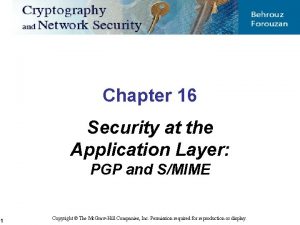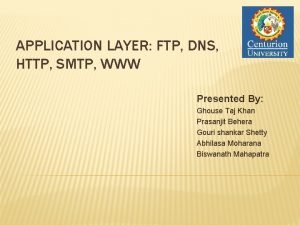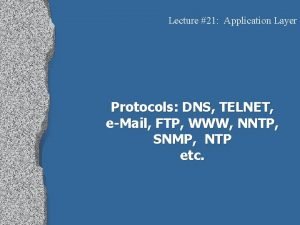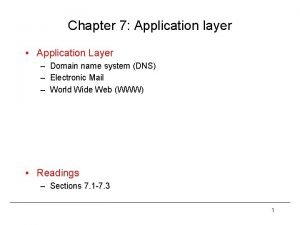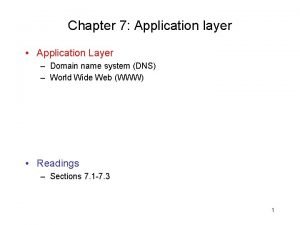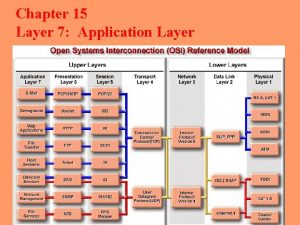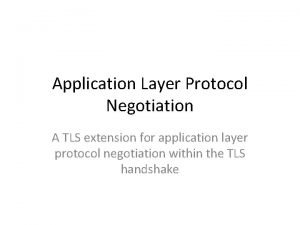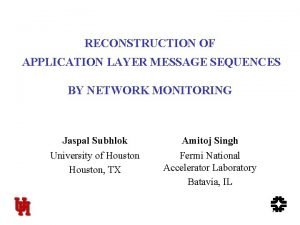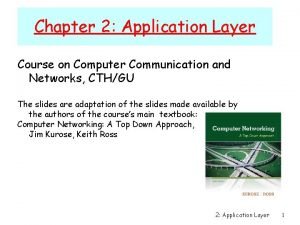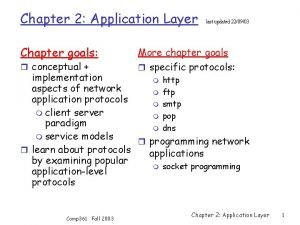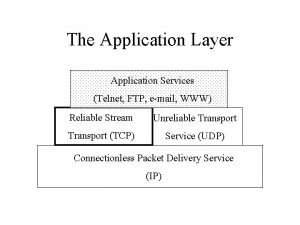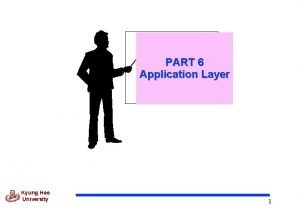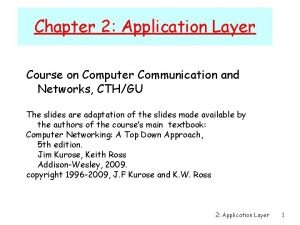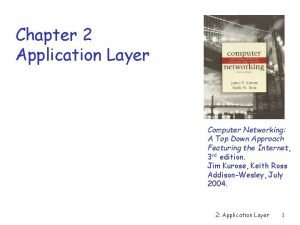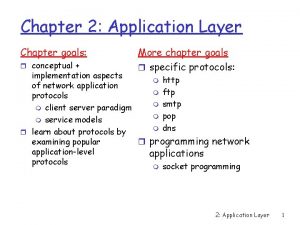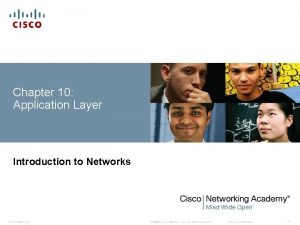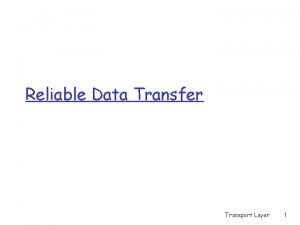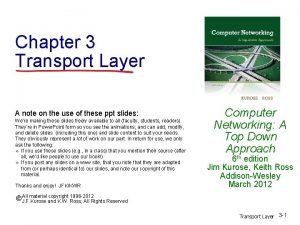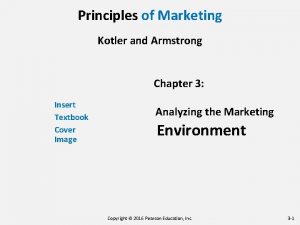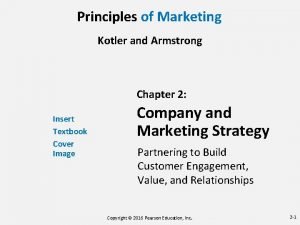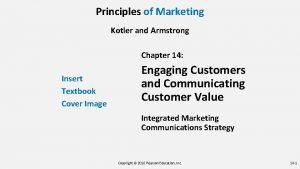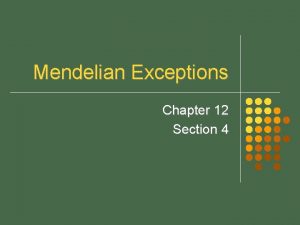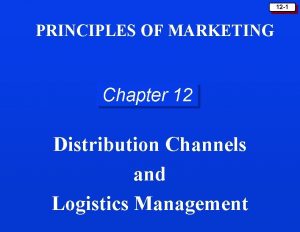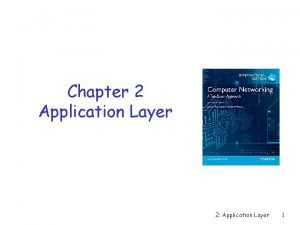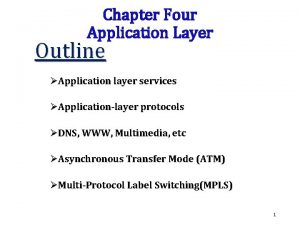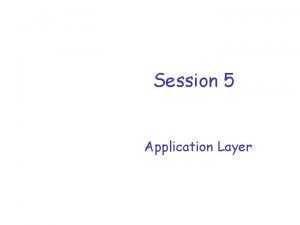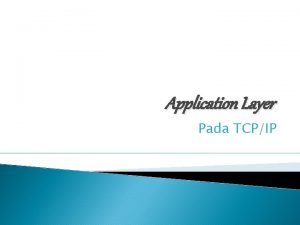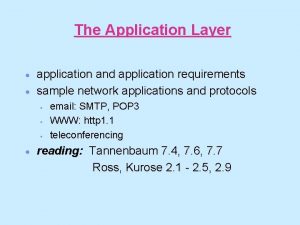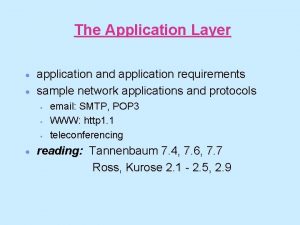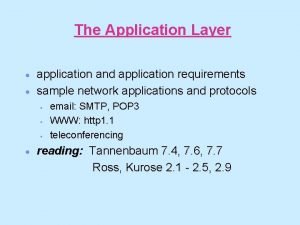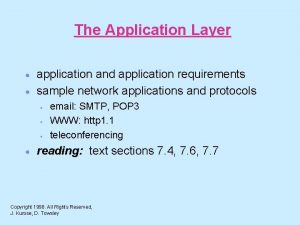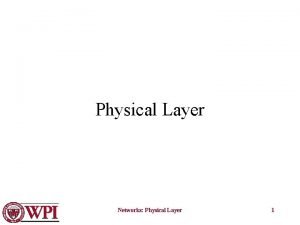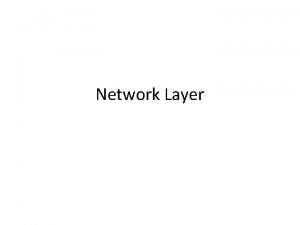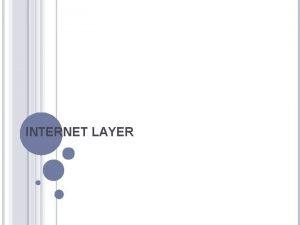Chapter 2 Application layer r 2 1 Principles





































![Electronic Mail: SMTP [RFC 2821] r uses TCP to reliably transfer email message from Electronic Mail: SMTP [RFC 2821] r uses TCP to reliably transfer email message from](https://slidetodoc.com/presentation_image_h/fd8c4f6e479b1d502846626c9a911455/image-38.jpg)























- Slides: 61

Chapter 2: Application layer r 2. 1 Principles of network applications r 2. 2 Web and HTTP r 2. 3 FTP r 2. 4 Electronic Mail v r 2. 6 P 2 P Applications r 2. 7 Socket programming with TCP r 2. 8 Socket programming with UDP SMTP, POP 3, IMAP r 2. 5 DNS 2: Application Layer 1

Some network apps r e-mail r voice over IP r web r real-time video r instant messaging r remote login conferencing r grid computing r P 2 P file sharing r multi-user network games r streaming stored video clips 2: Application Layer 2

Application architectures r Client-server r Peer-to-peer (P 2 P) r Hybrid of client-server and P 2 P 2: Application Layer 3

Client-server architecture server: v always-on host v permanent IP address clients: v v client/server v communicate with server may have dynamic IP addresses do not communicate directly with each other 2: Application Layer 4

Pure P 2 P architecture r no always-on server r arbitrary end systems directly communicate peer-peer r peers are intermittently connected and change IP addresses r example: Gnutella Highly scalable but difficult to manage 2: Application Layer 5

Hybrid of client-server and P 2 P Skype v voice-over-IP P 2 P application v centralized server: finding address of remote party: v client-client connection: direct (not through server) Instant messaging v chatting between two users is P 2 P v centralized service: client presence location • user registers its IP address with central server when it comes online • user contacts central server to find IP addresses of friends 2: Application Layer 6

Processes communicating Process: program running. r within same host, two processes communicate using inter-process communication. r processes in different hosts communicate by exchanging messages Client process: process that initiates communication Server process: process that waits to be contacted 2: Application Layer 7

Sockets r process sends/receives messages to/from its socket host or server process controlled by app developer process socket TCP with buffers, variables Internet TCP with buffers, variables controlled by OS 2: Application Layer 8

Addressing processes r host device has unique 32 -bit IP address r processes can be running on same host r identifier includes both IP address and port numbers associated with process on host. r Example port numbers: v HTTP server: 80 v Mail server: 25 r to send HTTP message to gaia. cs. umass. edu web server: v v IP address: 128. 119. 245. 12 Port number: 80 2: Application Layer 9

What transport service does an app need? Data loss r some apps (e. g. , audio) can tolerate some loss r other apps (e. g. , file transfer, telnet) require 100% reliable data transfer Bandwidth r some apps (e. g. , multimedia) require minimum amount of bandwidth to be “effective” Timing r some apps (e. g. , Internet telephony, interactive games) require low delay to be “effective” 2: Application Layer 10

Transport service requirements of common apps Data loss Bandwidth Time Sensitive file transfer e-mail Web documents real-time audio/video no loss-tolerant no no no yes, 100’s msec stored audio/video interactive games instant messaging loss-tolerant no loss elastic audio: 5 kbps-1 Mbps video: 10 kbps-5 Mbps same as above few kbps up elastic Application yes, few secs yes, 100’s msec yes and no 2: Application Layer 11

Internet transport protocols services TCP service: r connection-oriented: setup r r required between client and server processes reliable transport between sending and receiving process flow control: sender won’t overwhelm receiver congestion control: throttle sender when network overloaded does not provide: timing, minimum bandwidth guarantees UDP service: r unreliable data transfer between sending and receiving process r does not provide: connection setup, reliability, flow control, congestion control, timing, or bandwidth guarantee 2: Application Layer 12

Internet apps: application, transport protocols Application e-mail remote terminal access Web file transfer streaming multimedia Internet telephony Application layer protocol Underlying transport protocol SMTP [RFC 2821] Telnet [RFC 854] HTTP [RFC 2616] FTP [RFC 959] proprietary (e. g. Real. Networks) proprietary (e. g. , Vonage, Dialpad) TCP TCP TCP or UDP typically UDP 2: Application Layer 13

Chapter 2: Application layer r 2. 1 Principles of network applications r 2. 2 Web and HTTP r 2. 4 Electronic Mail v SMTP, POP 3, IMAP r 2. 6 P 2 P file sharing r 2. 7 Socket programming with TCP r 2. 8 Socket programming with UDP r 2. 5 DNS 2: Application Layer 14

Web and HTTP r Web page consists of objects r Object can be HTML file, JPEG image, Java applet, audio file, … r Web page consists of base HTML-file which includes several referenced objects r Each object is addressable by a URL r Example URL: www. someschool. edu/some. Dept/pic. gif host name path name 2: Application Layer 15

HTTP overview HTTP: hypertext transfer protocol r Web’s application layer protocol r client/server model v client: browser that requests, receives, “displays” Web objects v server: Web server sends objects in response to requests r HTTP 1. 0: RFC 1945 r HTTP 1. 1: RFC 2068 HT TP req ues PC running HT t TP res Explorer pon se st ue q e r P nse Server T o p running HT es r P T Apache Web HT server Mac running Navigator 2: Application Layer 16

HTTP overview (continued) Uses TCP: r client initiates TCP connection (creates socket) to server, port 80 r server accepts TCP connection from client r HTTP messages exchanged between browser (HTTP client) and Web server (HTTP server) r TCP connection closed HTTP is “stateless” r server maintains no information about past client requests 2: Application Layer 17

HTTP connections Nonpersistent HTTP r At most one object is sent over a TCP connection. r HTTP/1. 0 uses nonpersistent HTTP Persistent HTTP r Multiple objects can be sent over single TCP connection between client and server. r HTTP/1. 1 uses persistent connections in default mode 2: Application Layer 18

Nonpersistent HTTP (contains text, Suppose user enters URL references to 10 www. some. School. edu/some. Department/home. index jpeg images) 1 a. HTTP client initiates TCP connection to HTTP server at www. some. School. edu on port 80 2. HTTP client sends HTTP request message (containing URL) into TCP connection socket. Message indicates that client wants object some. Department/home. index 1 b. HTTP server at host www. some. School. edu waiting for TCP connection at port 80. “accepts” connection, notifying client 3. HTTP server receives request message, forms response message containing requested object, and sends message into its socket time 2: Application Layer 19

Nonpersistent HTTP (cont. ) 4. HTTP server closes TCP 5. HTTP client receives response connection. message containing html file, displays html. Parsing html file, finds 10 referenced jpeg objects time 6. Steps 1 -5 repeated for each of 10 jpeg objects 2: Application Layer 20

Non-Persistent HTTP: Response time Definition of RTT: time to send a packet to travel from client to server and back. Response time: total = 2 RTT+transmit time initiate TCP connection RTT request file RTT file received time to transmit file time 2: Application Layer 21

Persistent HTTP r server leaves connection open after sending response r subsequent HTTP messages between same client/server sent over open connection Persistent without pipelining: r client issues new request only when previous response has been received r one RTT for each referenced object Persistent with pipelining: r default in HTTP/1. 1 r client sends requests as soon as it encounters a referenced object 2: Application Layer 22

HTTP request message r two types of HTTP messages: request, response r HTTP request message: v ASCII (human-readable format) request line (GET, POST, HEAD commands) GET /somedir/page. html HTTP/1. 1 Host: www. someschool. edu User-agent: Mozilla/4. 0 header Connection: close lines Accept-language: fr Carriage return, line feed indicates end of message (extra carriage return, line feed) 2: Application Layer 23

HTTP request message: general format 2: Application Layer 24

Uploading form input Post method: r Web page often includes form input r Input is uploaded to server in entity body URL method: r Uses GET method r Input is uploaded in URL field of request line: www. somesite. com/animalsearch? monkeys&banana 2: Application Layer 25

HTTP response message status line (protocol status code status phrase) header lines data, e. g. , requested HTML file HTTP/1. 1 200 OK Connection close Date: Thu, 06 Aug 1998 12: 00: 15 GMT Server: Apache/1. 3. 0 (Unix) Last-Modified: Mon, 22 Jun 1998 …. . . Content-Length: 6821 Content-Type: text/html data data. . . 2: Application Layer 26

HTTP response status codes In first line in server->client response message. A few sample codes: 200 OK v request succeeded, requested object later in this message 301 Moved Permanently v requested object moved, new location specified later in this message (Location: ) 400 Bad Request v request message not understood by server 404 Not Found v requested document not found on this server 505 HTTP Version Not Supported 2: Application Layer 27

User-server state: cookies Many major Web sites use cookies Four components: 1) cookie header line of HTTP response message 2) cookie header line in HTTP request message 3) cookie file kept on user’s host, managed by user’s browser 4) back-end database at Web site Cookies and privacy: r cookies permit sites to learn a lot about you r you may supply name and e-mail to sites 2: Application Layer 28

Web caches (proxy server) Goal: satisfy client request without involving origin server r user sets browser: Web accesses via cache r browser sends all HTTP requests to cache v v object in cache: cache returns object else cache requests object from origin server, then returns object to client origin server HT client. HTTP TP req ues Proxy server t res pon se t s ue q re P nse o T p HT es r TP T H client est u q e Pr T nse o p HT res P T HT origin server 2: Application Layer 29

More about Web caching r cache acts as both client and server r typically cache is installed by ISP (university, company, residential ISP) Why Web caching? r reduce response time for client request r reduce traffic on an institution’s access link. 2: Application Layer 30

Chapter 2: Application layer r 2. 1 Principles of network applications r 2. 2 Web and HTTP r 2. 3 FTP r 2. 4 Electronic Mail v SMTP, POP 3, IMAP r 2. 5 DNS r 2. 6 P 2 P file sharing r 2. 7 Socket programming with TCP r 2. 8 Socket programming with UDP r 2. 9 Building a Web server 2: Application Layer 31

FTP: the file transfer protocol user at host FTP user client interface file transfer local file system FTP server remote file system r transfer file to/from remote host r client/server model client: side that initiates transfer (either to/from remote) v server: remote host r ftp: RFC 959 r ftp server: port 21 v 2: Application Layer 32

FTP: separate control, data connections TCP control connection port 21 r FTP client contacts FTP server r r at port 21, TCP client authorized over control connection client sending commands over control connection. when server receives file transfer command, server opens 2 nd TCP connection to client after transferring one file, server closes data connection. FTP client TCP data connection port 20 FTP server r server opens another TCP data connection to transfer another file. r control connection: “out of band” 2: Application Layer 33

FTP commands, responses Sample commands: Sample return codes r sent as ASCII text over r status code and phrase (as control channel r USER username r PASS password r LIST return list of file in r r current directory r RETR filename retrieves r r STOR filename stores r (gets) file (puts) file onto remote host in HTTP) 331 Username OK, password required 125 data connection already open; transfer starting 425 Can’t open data connection 452 Error writing file 2: Application Layer 34

Chapter 2: Application layer r 2. 1 Principles of network applications r 2. 2 Web and HTTP r 2. 3 FTP r 2. 4 Electronic Mail v SMTP, POP 3, IMAP r 2. 5 DNS r 2. 6 P 2 P file sharing r 2. 7 Socket programming with TCP r 2. 8 Socket programming with UDP r 2. 9 Building a Web server 2: Application Layer 35

Electronic Mail outgoing message queue user mailbox user agent Three major components: r user agents r mail servers mail server SMTP r simple mail transfer protocol: SMTP User Agent r composing, editing, reading mail messages r e. g. , Eudora, Outlook, elm, Mozilla Thunderbird r outgoing, incoming messages stored on server SMTP mail server user agent SMTP user agent mail server user agent 2: Application Layer 36

Electronic Mail: mail servers user agent Mail Servers r mailbox contains incoming messages for user r message queue of outgoing (to be sent) mail messages r SMTP protocol between mail servers to send email messages mail server SMTP mail server user agent SMTP user agent mail server user agent 2: Application Layer 37
![Electronic Mail SMTP RFC 2821 r uses TCP to reliably transfer email message from Electronic Mail: SMTP [RFC 2821] r uses TCP to reliably transfer email message from](https://slidetodoc.com/presentation_image_h/fd8c4f6e479b1d502846626c9a911455/image-38.jpg)
Electronic Mail: SMTP [RFC 2821] r uses TCP to reliably transfer email message from client to server, port 25 r direct transfer: sending server to receiving server r three phases of transfer v handshaking (greeting) v transfer of messages v closure r command/response interaction v commands: ASCII text v response: status code and phrase r messages must be in 7 -bit ASCII 2: Application Layer 38

Scenario: Alice sends message to Bob 4) SMTP client sends Alice’s message over the TCP connection 5) Bob’s mail server places the message in Bob’s mailbox 6) Bob invokes his user agent to read message 1) Alice uses UA to compose message and “to” bob@someschool. edu 2) Alice’s UA sends message to her mail server; message placed in message queue 3) Client side of SMTP opens TCP connection with Bob’s mail server 1 user agent 2 mail server 3 mail server 4 5 6 user agent 2: Application Layer 39

Sample SMTP interaction S: C: S: C: C: C: S: 220 hamburger. edu HELO crepes. fr 250 Hello crepes. fr, pleased to meet you MAIL FROM: <alice@crepes. fr> 250 alice@crepes. fr. . . Sender ok RCPT TO: <bob@hamburger. edu> 250 bob@hamburger. edu. . . Recipient ok DATA 354 Enter mail, end with ". " on a line by itself Do you like ketchup? How about pickles? . 250 Message accepted for delivery QUIT 221 hamburger. edu closing connection 2: Application Layer 40

Mail message format SMTP: protocol for exchanging email msgs RFC 822: standard for text message format: r header lines, e. g. , To: v From: v Subject: different from SMTP commands! v header blank line body r body v the “message”, ASCII characters only 2: Application Layer 41

Message format: multimedia extensions r MIME: multimedia mail extension, RFC 2045, 2056 r additional lines in msg header declare MIME content type MIME version method used to encode data multimedia data type, subtype, parameter declaration encoded data From: alice@crepes. fr To: bob@hamburger. edu Subject: Picture of yummy crepe. MIME-Version: 1. 0 Content-Transfer-Encoding: base 64 Content-Type: image/jpeg base 64 encoded data. . . . . base 64 encoded data 2: Application Layer 42

Mail access protocols user agent SMTP sender’s mail server access protocol user agent receiver’s mail server r SMTP: delivery/storage to receiver’s server r Mail access protocol: retrieval from server v v v POP: Post Office Protocol [RFC 1939] • authorization (agent <-->server) and download IMAP: Internet Mail Access Protocol [RFC 1730] HTTP: gmail, Hotmail, Yahoo! Mail, etc. 2: Application Layer 43

Chapter 2: Application layer r 2. 1 Principles of network applications r 2. 2 Web and HTTP r 2. 3 FTP r 2. 4 Electronic Mail v SMTP, POP 3, IMAP r 2. 5 DNS r 2. 6 P 2 P file sharing r 2. 7 Socket programming with TCP r 2. 8 Socket programming with UDP r 2. 9 Building a Web server 2: Application Layer 44

DNS : Domain Name System DNS services r hostname to IP address translation Why not centralize DNS? r single point of failure r traffic volume r distant centralized database r maintenance doesn’t scale! 2: Application Layer 45

Distributed, Hierarchical Database Root DNS Servers com DNS servers yahoo. com amazon. com DNS servers org DNS servers pbs. org DNS servers edu DNS servers poly. edu umass. edu DNS servers Client wants IP for www. amazon. com; 1 st approx: r client queries a root server to find com DNS server r client queries com DNS server to get amazon. com DNS server r client queries amazon. com DNS server to get IP address for www. amazon. com 2: Application Layer 46

DNS: Root name servers r contacted by local name server that can not resolve name r root name server: v v v contacts authoritative name server if name mapping not known gets mapping returns mapping to local name server a Verisign, Dulles, VA c Cogent, Herndon, VA (also LA) d U Maryland College Park, MD g US Do. D Vienna, VA h ARL Aberdeen, MD j Verisign, ( 21 locations) e NASA Mt View, CA f Internet Software C. Palo Alto, k RIPE London (also 16 other locations) i Autonomica, Stockholm (plus 28 other locations) m WIDE Tokyo (also Seoul, Paris, SF) CA (and 36 other locations) 13 root name servers worldwide b USC-ISI Marina del Rey, CA l ICANN Los Angeles, CA 2: Application Layer 47

DNS name resolution example root DNS server 2 r Host at cis. poly. edu wants IP address for gaia. cs. umass. edu iterated query: r contacted server replies with name of server to contact r “I don’t know this name, but ask this server” 3 4 TLD DNS server 5 local DNS server dns. poly. edu 1 8 requesting host 7 6 authoritative DNS server dns. cs. umass. edu cis. poly. edu gaia. cs. umass. edu 2: Application Layer 48

DNS name resolution example recursive query: root DNS server 2 r puts burden of name resolution on contacted name server r heavy load? 3 7 local DNS server dns. poly. edu 1 6 TLD DNS server 5 4 8 requesting host authoritative DNS server dns. cs. umass. edu cis. poly. edu gaia. cs. umass. edu 2: Application Layer 49

DNS protocol, messages DNS protocol : query and reply messages, both with same message format msg header r identification: 16 bit # for query, reply to query uses same # r flags: v query or reply v recursion desired v recursion available v reply is authoritative 2: Application Layer 50

DNS protocol, messages Name, type fields for a query RRs in response to query records for authoritative servers additional “helpful” info that may be used 2: Application Layer 51

Chapter 2: Application layer r 2. 1 Principles of network applications v v app architectures app requirements r 2. 2 Web and HTTP r 2. 4 Electronic Mail v SMTP, POP 3, IMAP r 2. 5 DNS r 2. 6 P 2 P file sharing r 2. 7 Socket programming with TCP r 2. 8 Socket programming with UDP r 2. 9 Building a Web server 2: Application Layer 52

P 2 P file sharing Example r Alice runs P 2 P client application on her notebook computer r intermittently connects to Internet; gets new IP address for each connection r asks for “Hey Jude” r application displays other peers that have copy of Hey Jude. r Alice chooses one of the peers, Bob. r file is copied from Bob’s PC to Alice’s notebook: HTTP r while Alice downloads, other users uploading from Alice. r Alice’s peer is both a Web client and a transient Web server. All peers are servers = highly scalable! 2: Application Layer 53

P 2 P: centralized directory original “Napster” design 1) when peer connects, it informs central server: v v Bob centralized directory server 1 peers IP address content 2) Alice queries for “Hey Jude” 3) Alice requests file from Bob 1 3 1 2 1 Alice 2: Application Layer 54

P 2 P: problems with centralized directory r single point of failure r performance bottleneck r copyright infringement: “target” of lawsuit is obvious file transfer is decentralized, but locating content is highly centralized 2: Application Layer 55

Query flooding: Gnutella r fully distributed v no central server r public domain protocol r many Gnutella clients implementing protocol overlay network: graph r edge between peer X and Y if there’s a TCP connection r all active peers and edges form overlay net r edge: virtual link r given peer typically connected with < 10 overlay neighbors 2: Application Layer 56

Gnutella: protocol r Query message sent over existing TCP connections r peers forward Query message ry e r Query. Hit it Qu H ry sent over e Qu reverse Query path File transfer: HTTP Query. Hit Qu ery Query. Hit Scalability: limited scope flooding Qu er y 2: Application Layer 57

Gnutella: Peer joining peer Alice must find another peer in Gnutella network: use list of candidate peers 2. Alice sequentially attempts TCP connections with candidate peers until connection setup with Bob 3. Flooding: Alice sends Ping message to Bob; Bob forwards Ping message to his overlay neighbors (who then forward to their neighbors…. ) r peers receiving Ping message respond to Alice with Pong message 4. Alice receives many Pong messages, and can then setup additional TCP connections Peer leaving: see homework problem! 1. 2: Application Layer 58

Hierarchical Overlay r between centralized index, query flooding approaches r each peer is either a group leader or assigned to a group leader. v v TCP connection between peer and its group leader. TCP connections between some pairs of group leaders. r group leader tracks content in its children 2: Application Layer 59

P 2 P Case study: Skype clients (SC) r P 2 P (pc-to-pc, pc-to- phone, phone-to-pc) Voice-Over-IP (Vo. IP) Skype application login server r hierarchical overlay Supernode (SN) 2: Application Layer 60

Skype: making a call r User starts Skype r SC registers with SN v list of bootstrap SNs r SC logs in Skype login server (authenticate) r Call: SC contacts SN will callee ID v SN contacts other SNs (unknown protocol, maybe flooding) to find addr of callee; returns addr to SC r SC directly contacts callee, over. TCP 2: Application Layer 61
 Pigmented layer and neural layer
Pigmented layer and neural layer Parietal layer and visceral layer
Parietal layer and visceral layer Secure socket layer and transport layer security
Secure socket layer and transport layer security Presentation layer functions
Presentation layer functions Secure socket layer and transport layer security
Secure socket layer and transport layer security Secure socket layer and transport layer security
Secure socket layer and transport layer security Secure socket layer and transport layer security
Secure socket layer and transport layer security Layer 2 e layer 3
Layer 2 e layer 3 Layer-by-layer assembly
Layer-by-layer assembly Layer 2 vs layer 3 bitstream
Layer 2 vs layer 3 bitstream Security at application layer pgp and s/mime
Security at application layer pgp and s/mime Ftp application layer
Ftp application layer Dns application layer protocol
Dns application layer protocol Domain name system in application layer
Domain name system in application layer Application layer domain name system
Application layer domain name system Layer 7 application
Layer 7 application Application layer protocol negotiation
Application layer protocol negotiation Application layer message
Application layer message Introduction to application layer
Introduction to application layer Application layer protocols
Application layer protocols Application layer protocols
Application layer protocols Thin client vs thick client
Thin client vs thick client Telnet
Telnet Application layer
Application layer Application layer
Application layer Application layer protocols
Application layer protocols Application layer protocols
Application layer protocols Application layer protocols
Application layer protocols Anirban mahanti
Anirban mahanti Principles of reliable data transfer in transport layer
Principles of reliable data transfer in transport layer Ultrasonic inspection machine
Ultrasonic inspection machine Principles of cast application
Principles of cast application Chapter 3 transport layer
Chapter 3 transport layer Preparing for the world of work
Preparing for the world of work Chapter 17:3 completing job application forms
Chapter 17:3 completing job application forms Chapter 3 application software
Chapter 3 application software Chapter 5 elasticity and its application multiple choice
Chapter 5 elasticity and its application multiple choice Chapter 9 application: international trade answers
Chapter 9 application: international trade answers Chapter 30 principles of pharmacology
Chapter 30 principles of pharmacology Chapter 7 marketing
Chapter 7 marketing Chapter 5 principles of marketing
Chapter 5 principles of marketing Chapter 3 principles of marketing
Chapter 3 principles of marketing Kotler marketing strategy
Kotler marketing strategy 14 principles of marketing
14 principles of marketing Physics principles and problems chapter 6 answers
Physics principles and problems chapter 6 answers Chapter 12 lesson 2 applying mendels principles
Chapter 12 lesson 2 applying mendels principles Chapter 12 lesson 2 applying mendels principles
Chapter 12 lesson 2 applying mendels principles Child development principles and theories
Child development principles and theories Chapter 8 lesson 1 principles of the constitution
Chapter 8 lesson 1 principles of the constitution Chapter 5 principles of voice leading answers
Chapter 5 principles of voice leading answers Chapter 5 principles of engine operation
Chapter 5 principles of engine operation Chapter 28 unemployment problems and applications answers
Chapter 28 unemployment problems and applications answers Principles of ecology section 2 flow of energy
Principles of ecology section 2 flow of energy Principles of ecology chapter 2 answer key
Principles of ecology chapter 2 answer key Principles of ecology chapter 2
Principles of ecology chapter 2 Parallel lines milady
Parallel lines milady Chapter 12 lesson 2 applying mendels principles
Chapter 12 lesson 2 applying mendels principles Marketing chapter 8
Marketing chapter 8 Principles of marketing chapter 2
Principles of marketing chapter 2 Principles of marketing chapter 12
Principles of marketing chapter 12 Chapter 3 marketing
Chapter 3 marketing Creating customer value and engagement
Creating customer value and engagement










